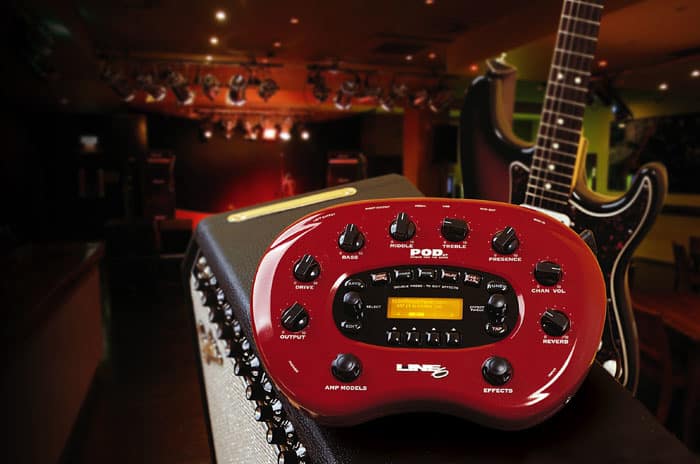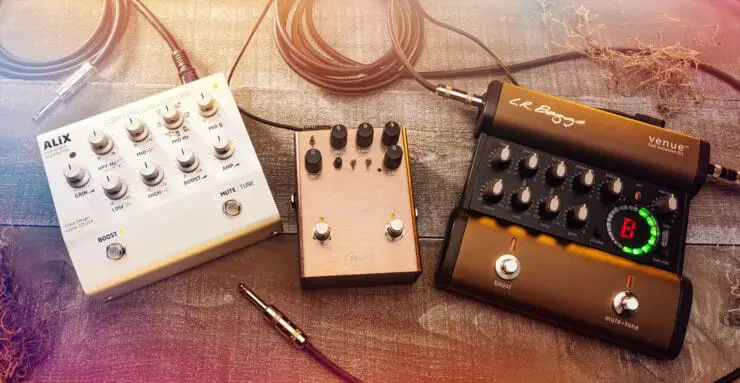Are you a guitar player looking for a good preamp for your instrument? Preamps are essential for getting the best sound out of your guitar and can make a big difference in the sound quality. In this article, we will discuss the features of a good guitar preamp and how they can help you get the best sound out of your instrument. So, if you want to know more about preamps and how to choose the right one for your guitar, keep reading!
Overview of guitar preamps
In the world of electric guitars and amplification, the preamp is an important component that plays a key role in shaping the guitar’s tone and preparing the signal for further amplification. But what exactly is a guitar preamp and how does it work?
A guitar preamp is an electronic circuit or device that processes the raw signal generated by the guitar’s pickups before sending it to the main amplifier. It is typically located within the guitar itself or as a separate unit in the signal chain between the guitar and the amplifier. The primary function of a guitar preamp is to boost the low-level signal produced by the pickups to a higher level, as well as to shape and equalize the sound according to the player’s preferences.
>>> Click here to read our review about the Top 15 Best Guitar Preamps <<<
To understand how a guitar preamp works, it’ll be important to have a closer look at its main components and their functions.
The preamp contains a gain stage that amplifies the weak electrical signal generated by the guitar pickups. This stage increases the signal level to a point where it can be effectively processed and amplified by the main amplifier. The gain control on the preamp allows the musician or guitarist to adjust the level of amplification allowing for clean or distorted tones.
Most guitar preamps feature tone controls like bass, treble, and middle knobs or sliders. These controls shape the frequency response of the guitar signal, allowing you to adjust the tonal characteristics to your liking. By boosting or cutting specific frequency ranges, the preamp can add warmth, brightness, or presence to the guitar’s sound.
Another critical function of the preamp will be impedance matching. Impedance refers to the electrical resistance within the guitar’s pickups and the input of the main amp. The preamp adjusts the impedance of the guitar’s signal to match the impedance requirements of the amp, ensuring optimum signal transfer and preventing loss of high-frequency content.
Aside from gain and equalization, the preamp might also include additional features for signal conditioning. This can involve compression, distortion, or other effects that shape the guitar’s tone. Some preamps also offer built-in effects like chorus, reverb, or delay, providing a range of sonic possibilities without the need for external pedals.
The preamp’s output stage sends the processed guitar signal to the amp or audio interface. It ensures that the signal level is appropriate for further amplification or recording. The output stage might also provide a buffered signal to prevent loss of high-frequency content because of cable capacitance and other factors.
It is worth mentioning that the guitar preamp works in conjunction with the power amplifier, which amplifies the preamp’s signal to a level that can drive speakers or headphones. The preamp’s role is to shape and prepare the guitar signal whereas the power amp focuses on amplification.

Benefits of using a good guitar preamp
When it comes to achieving the best possible tone and versatility from your electric guitar, using a good guitar preamp can make a massive difference. Whether it is built into your guitar or as a standalone unit in your signal chain, a guitar preamp offers numerous benefits that can enhance your playing experience and overall sound. Here are some of the benefits of using a good guitar preamp –
#1. Signal boost and amplification control
One of the primary functions of a guitar preamp is to boost the weak electrical signals generated by the guitar’s pickups. The gain stage will allow you to increase the signal level before it reaches the amplifier, ensuring that even subtle nuances of your playing are accurately reproduced. With a preamp, you’ll have greater control over the overall volume, allowing you to adjust your output to match different playing environments or to drive the amp into natural tube overdrive for added warmth and dynamics.
#2. Tone shaping and equalization
A guitar preamp provides a wide range of tone-shaping controls such as bass, treble, and middle knobs or sliders. These controls will allow you to adjust the frequency response of your guitar’s signal, enabling you to shape your tone according to your preferences and the musical style you’re playing.
With a preamp, you’ll be able to boost or cut specific frequency ranges, sculpting your sound to suit different musical genres or to achieve your desired tonal character. This versatility will give you the freedom to experiment and find your unique sound.
#3. Impedance matching and signal conditioning
Another benefit of using a guitar preamp is its ability to match the impedance between your guitar’s pickups and the input of the main amp. This ensures optimal signal transfer, reducing signal loss and preserving the high-frequency content of your guitar’s tone.
Moreover, many preamps offer signal conditioning features such as compression or distortion, allowing you to further shape and refine your sound. These capabilities enable you to add warmth, sustain, or a touch of grit to your tone without the need for additional effects pedals.
#4. Versatility and convenience
By using a separate guitar preamp unit, you will have the advantage of portability and versatility. You can easily swap the preamp between different guitars or amplifiers, tailoring your tone to suit each instrument or performance setting.
Moreover, many standalone preamps offer added features such as built-in effects, headphone outputs, and direct recording capabilities, allowing you to practice, perform, or record without the need for extensive gear setups. This convenience makes a preamp an extremely valuable tool for musicians who require flexibility and ease of use.
#5. Enhanced control and personalization
With a guitar preamp, you will get greater control over your instrument’s sonic characteristics. The ability to shape your tone, adjust gain levels, and fine-tune your sound empowers you to express yourself more effectively as a musician or guitarist.
Whether you prefer clean and pristine tones or aggressive and distorted sounds, a preamp will allow you to achieve the desired texture and responsiveness, reflecting your unique artistic vision and playing style.
What are the features of a good guitar preamp?
A guitar preamp is an important component in any guitarist’s setup as it shapes and refines the tone of their instrument before it reaches the amplifier or recording interface. A good guitar preamp offers a wide range of features that contribute to achieving the desired sound and unlocking the full potential of the instrument. A quality guitar preamp can make a significant difference in achieving the desired sound and unlocking the full potential of your guitar. Here, you will get to know what are the features of a good guitar preamp to take your playing experience to the next level.
#1. Tone controls
Tone controls are an integral part of any guitar preamp, giving you the ability to shape the frequency response of your instrument. Typically, preamps include controls such as bass, treble, and middle knobs. These controls will allow you to boost or cut specific frequency ranges, allowing you to tailor your tone according to your preferences and the musical style that you’re playing. With effective tone controls, you’ll be able to achieve anything from warm and mellow tones to bright and cutting sounds.
#2. Gain control
The gain control on a guitar preamp determines the level of amplification applied to your guitar’s signal. This feature is especially important for achieving different levels of overdrive and distortion. By adjusting the gain, you’ll be able to control the amount of saturation and sustain. This will allow you to achieve anything from a clean tone to a fully saturated and aggressive sound.
A good guitar preamp will provide a responsive and well-balanced gain control that allows for dynamic playing and a wide range of tonal possibilities.
#3. EQ settings
In addition to basic tone controls, a good guitar preamp often includes more advanced EQ settings. This might include parametric or graphic equalizers, allowing you to fine-tune specific frequency bands. With a parametric EQ, you’ll have control over the center frequency, bandwidth, and gain for each band, providing more precise control over your tone.
This level of flexibility will allow you to shape your sound with surgical precision, making it ideal for studio recording or live performances where precise tonal adjustments are needed.

#4. Effects loops
Many guitar preamps feature effects loops, which allow you to integrate external effects pedals or processors into your signal chain. An effects loop will allow you to place time-based effects like delays and reverbs after the preamp stage, ensuring that these effects are applied to the processed guitar signal instead of the raw guitar input. This preserves the clarity of the preamp’s tone while still letting you optimize the full capacities of your effects pedals.
#5. Connectivity options
A good guitar preamp offers an impressive range of connectivity options to suit different setups and recording requirements. This includes outputs for connecting to amplifiers or audio interfaces, headphone outputs for private practice or monitoring, and direct recording options for connecting to recording devices or interfaces.
Moreover, some preamps offer balanced XLR outputs for direct connection to mixing consoles or studio equipment, allowing for easy integration into professional recording environments.
Many modern guitar preamps often come equipped with USB or MIDI connectivity, enabling seamless integration with DAWs and software-based guitar effects. This connectivity will allow for direct recording, re-amping, and software control of the preamp, delivering a wealth of possibilities for recording and performance applications.
#6. Clean and transparent signal path
An important feature of a good guitar preamp will be a clean and transparent signal path. It should faithfully reproduce the nuances and dynamics of your playing without coloring the sound.
A good guitar preamp will ensure that the original character of your guitar and pickups shine through, allowing you to achieve that pure and unaltered tone. This feature is quite important if you prefer using external effects pedals or processors to shape your sound.
#7. Durability and build quality
Lastly, a good quality guitar preamp should be built to withstand the rigors of live performances and regular use. You should look for preamps that are made with high-quality components and solid construction.
A good guitar preamp will be more reliable, ensuring that it continues to perform optimally over time. Moreover, you should consider factors like portability, ease of use, and intuitive controls to ensure a seamless playing experience.
Different types of guitar preamps
A guitar preamp helps in shaping and enhancing the tone of an electric guitar amp before it reaches the amp or recording interface. There are different types of guitar preamps available, each offering unique characteristics and features. Here are some of the common types of guitar preamps, their characteristics, and what they are all about.
#1. Tube preamps
Tube preamps or also known as valve preamps make use of vacuum tubes to amplify the guitar signal. These preamps are known best for their warm and organic sound, with rich harmonics and smooth saturation. Tube preamps offer a natural compression and responsiveness that adds depth and character to the guitar tone. They are widely regarded for their ability to produce classic vintage tones and are favored by many musicians and guitarists in the blues, rock, and jazz genres.
#2. Solid-state preamps
Solid-state preamps use transistors and other solid-state components for amplification. They’re known best for their reliability, consistency, and clean signal reproduction. Solid-state preamps offer a more transparent and neutral sound, faithfully capturing the tonal characteristics of the guitar and pickups without adding additional coloration. They’re preferred for their precision, clarity, and ability to handle high-gain settings, making them popular in genres like metal and progressive rock.

#3. Digital modeling preamps
Digital modeling preamps make use of digital technology for simulating the sound of various amplifiers, cabinets, and effects. These preamps often feature extensive libraries of amp and effect modulations, allowing guitarists to access an impressive range of tones within a single unit.
Digital modeling preamps offer versatility, enabling guitarists to replicate the characteristics of different vintage and modern amplifiers and experiment with various effects. They’re particularly useful for recording applications and live performances where portability and convenience are important.
#4. Hybrid preamps
Hybrid preamps combine the best of both worlds as they incorporate different tube and solid-state components. These preamps typically use a tube for the preamp stage and solid-state circuitry for the power amp section.
The aim is to harness the warmth and harmonic richness of tubes while benefiting from the reliability and consistency of solid-state technology. Hybrid preamps offer a balance between vintage warmth and modern precision, providing a versatile tonal palette that suits various musical styles.
#5. Built-in preamps
Some electric guitars come equipped with built-in preamps. These preamps are typically located in the guitar’s control cavity and offer onboard tone shaping and amplification options. These preamps also include features like equalization controls, gain adjustments, and other built-in effects. They deliver convenience and stability, allowing players to shape their tone without the need for external preamp units.
How to choose a good guitar preamp
A high-quality guitar preamp will allow you to fine-tune your sound, add coloration, and unlock the full potential of your guitar. With an impressive range of options available on the market, selecting the right guitar preamp can be a daunting task. However, it becomes quite easy as long as you know what you are looking for. Here are the steps you need to keep in mind to choose a guitar preamp that suits your requirements.
#1. Determine your purpose
Before diving into the technical specifications, you must consider your purpose for using a guitar preamp. Are you a gigging musician who is just looking for a versatile preamp to use in various live settings? Are you a recording artist who requires a preamp with direct recording capabilities? Identifying your purpose will help in narrowing down your options and focus on the features that matter most to you.
#2. Understand the types of preamp options available for you
You need to familiarize yourself with the different types of preamps available. This includes tube preamps, solid-state preamps, hybrid preamps, digital modeling preamps, and built-in preamps.
Each type has its unique characteristics and sonic qualities. You must carry out thorough research and listen to examples of each type to get a good sense of the sound they produce. You should also consider the genres of music you play and the specific tones that you are aiming to achieve.
#3. Consider your preferred tone
Every guitarist has a specific tonal preference. You must think about the type of sound you want to achieve with your guitar. Do you prefer warm and vintage tones or you’re looking for a more modern, high-gain sound?
Tube preamps are renowned for their warm and organic sound whereas solid-state and digital preamps offer a cleaner and more precise tone. Meanwhile, modeling preamps offer versatility by emulating the sounds of various amps and effects. You should consider your preferred genres and the tones of your favorite guitarists to guide your decision.
#4. Evaluate control options
Assess the different control options offered by the preamp. Look for preamps that have intuitive and comprehensive control layouts that allow you to shape your sound precisely. Consider the availability of tone controls, gain settings, and equalizer options, and additional features like impulse responses or built-in effects. Make sure that the preamp provides enough flexibility to sculpt your tone according to your preferences and the musical styles of your play.
#5. Connectivity and compatibility
You should consider the connectivity options offered by the preamp. Does it offer the necessary input and output connections for your specific setup? If you’re planning on using the preamp for recording, make sure that it has direct recording capabilities, such as USB or XLR outputs.
If you intend on using external effects pedals, you should check if the preamp has effects loops for seamless integration. You should consider compatibility with your existing gear, such as recording interfaces, amplifiers, or mixing consoles.
#6. Quality and reliability
You should investigate the build quality and reliability of the preamp. Read various reviews and user feedback to gain insights into the durability and longevity of the product. Look for preamps from reputable brands with a history of manufacturing reliable and high-quality gear. A well-built preamp will be able to withstand the demand of regular use and provide you with consistent performance over time.
#7. Test and compare
If possible, you should try out different preamps before making the final decision. Visit music stores, attend guitar shows, or borrow gear from fellow musicians to test different preamp options.
You should play your own guitar through the preamps and listen carefully to how they affect your tone. Pay close attention to the responsiveness, dynamics, and overall feel of each preamp. Take note of all the features and controls that resonate with you and make a shortlist of your preferred options and why you like them.
FAQs
What are the main features of a good guitar preamp?
A good guitar preamp should have a low noise floor, adjustable tone controls, and a wide range of gain levels. It should also provide clarity and definition, allowing you to achieve the desired sounds and tones. In addition, it should be compact and easy to use.
What types of preamps are available?
There are several types of preamps available, including tube preamps, solid state preamps, and modeling preamps. Tube preamps are known for their warm and smooth sound, while solid state preamps are known for their clarity and definition. Modeling preamps offer the ability to emulate classic amp tones, but may lack the warmth of tube preamps.
What other factors should I consider when choosing a guitar preamp?
When choosing a preamp, you should consider the type and style of music you play, the sound you are trying to achieve, and your budget. You should also consider the size and portability of the preamp, as well as the features and controls it offers. It’s important to find the right balance of these factors to ensure you get a preamp that meets your needs and provides a great playing experience.



